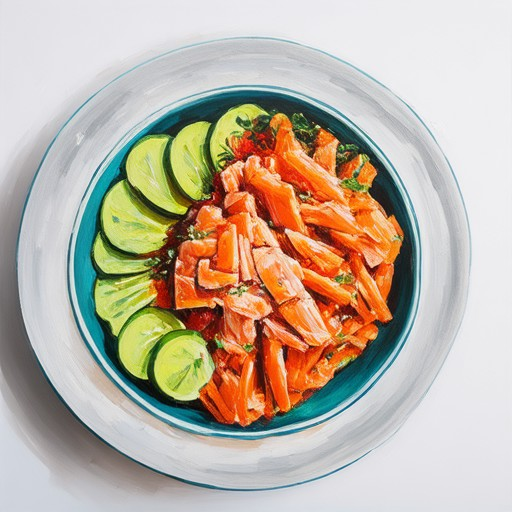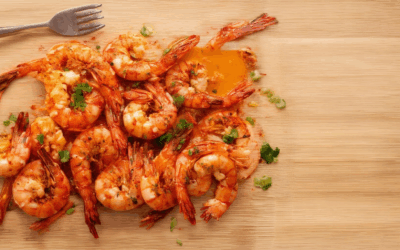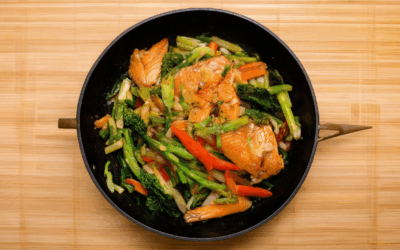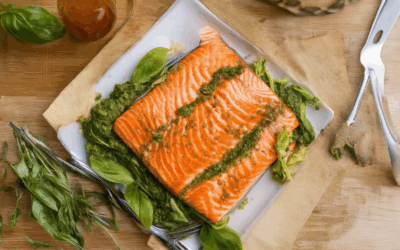Discover the art of crafting the ultimate tuna poke bowl with our comprehensive guide. Whether you’re a seasoned foodie or new to the culinary world, this versatile dish offers a delightful blend of flavors, textures, and nutritional benefits. From selecting the freshest ingredients to mastering the perfect marinade, our guide walks you through everything you need to know to create a mouthwatering tuna poke bowl that’s sure to impress. Explore the health advantages, discover regional variations, and learn expert tips for achieving the best results. With detailed instructions and practical advice, this guide ensures your tuna poke bowl is not only delicious but also a nutritious and satisfying meal. Dive in and elevate your cooking game with our expert insights!
Key Takeaways
– Marinating Tuna is Essential: Achieve authentic poke flavor by marinating raw tuna in a mixture of soy sauce, sesame oil, green onions, garlic, ginger, and optional chili flakes.
– Best Tuna for Poke: Opt for yellowfin tuna (also known as ahi) for its rich flavor and medium fat content. Use albacore or bigeye as alternatives, depending on availability and preference.
– Poke Sauce Basics: Create a balanced sauce with soy sauce, sesame oil, rice vinegar, garlic, ginger, sugar, and water. Customize with optional additions like citrus juice or chili flakes for extra flavor.
– Slicing Technique Matters: Use a sharp knife to slice tuna thinly against the grain for optimal texture.
– Sustainability Matters: Choose brands committed to sustainable fishing practices to support eco-friendly eating habits.

What Goes In a Tuna Poke Bowl?
A tuna poke bowl is a vibrant and flavorful dish that combines fresh ingredients to create a delicious meal. Here’s a breakdown of what typically goes into a classic tuna poke bowl:
- Base: Sushi rice is the foundation of the bowl, providing a smooth and savory bed for the other ingredients.
- Star Ingredient: Fresh, high-quality tuna is the centerpiece. It’s usually cut into small cubes or thin slices for ease of eating.
- Toppings:
- Avocado slices for creaminess and a refreshing taste
- Cucumber for crunch and freshness
- Pickled ginger for a tangy kick
- Green onions or wasabi for a spicy note
- Furikake (a blend of bonito, kombu, and chili powder) for extra flavor and texture
- Seaweed salad for a nutty flavor and fiber
- Sauces and Dressings:
- Soy sauce as a base
- Sesame oil for a smooth finish
- Sriracha or gochugaru for those who prefer spicy food
- Optional Add-Ons:
- Masago (gold flakes made from tuna)
- Edamame beans for extra protein and texture
- Tobiko (flying fish roe) for a burst of color and flavor
The bowl is assembled by placing the seasoned sushi rice at the bottom, followed by the raw tuna mixture, and then arranging the toppings and sauces on top. It’s a perfect balance of textures and flavors, making it a satisfying and visually appealing dish.
Is Tuna Poke Bowl Healthy?
A tuna poke bowl can be a healthy option when prepared mindfully. Here’s a breakdown of its nutritional aspects:
Nutritional Benefits:
- Protein Source: Tuna provides high-quality protein, essential for muscle repair and growth.
- Omega-3 Fatty Acids: Tuna is rich in omega-3s, particularly docosahexaenoic acid (DHA), which supports brain health and reduces inflammation.
- Vitamins and Minerals: It contains vitamin D, vitamin B12, and minerals like selenium and magnesium, which are vital for overall health.
Potential Downsides:
- Merccury Content: Tuna, especially larger varieties like albacore, may contain higher levels of mercury. Excessive consumption can lead to health risks.
- Allergies and Sensitivities: Some individuals may be allergic to fish or certain ingredients in the poke bowl, such as soy sauce or sesame oil.
How to Make It Healthier:
- Portion Control: Stick to recommended serving sizes to avoid excessive mercury intake.
- Choose Lower-Mercury Tuna: Opt for smaller fish like yellowfin or white tuna.
- Add Vegetables: Incorporate plenty of fresh veggies like mango, pineapple, bell peppers, and carrots for added fiber and nutrients.
- Balance the Bowl: Use brown rice or quinoa instead of white rice for whole grains.
- Limit Sauce Use: Use small amounts of soy sauce or sriracha to reduce sodium intake.
By balancing the ingredients and moderating portion sizes, a tuna poke bowl can be a nutritious and satisfying meal choice.

What is in a Traditional Poke Bowl?
A traditional poke bowl is a vibrant and flavorful dish that combines fresh raw fish with a variety of toppings and seasonings. Here’s a breakdown of its key components:
Base Ingredients
- Fish: The star of the bowl, typically featuring raw salmon, tuna, yellowtail, or albacore.
- Rice: A bed of white rice, often served as the base of the bowl.
Toppings and Mix-Ins
- Cheese: Feta cheese is a popular addition for its creamy texture and rich flavor.
- Avocado Slices: Adds creaminess and healthy fats to the dish.
- Cucumber: Provides a crunchy and refreshing element.
- Pickled Ginger: Offers a tangy and slightly spicy kick.
- Sweet Potato: Sometimes included for its earthy taste and vibrant color.
- Green Onions: Used for their mild flavor and vibrant appearance.
- Sesame Seeds: Sprinkled on top for a nutty aroma and texture.
Sauces and Dressings
- Soy Sauce: Essential for balancing the dish’s flavors.
- Sriracha or Chili Oil: Optional for those who prefer heat.
- Yuzu Juice: Adds a bright citrus note to the bowl.
Garnishes
- Nori Strips: Often used for their umami flavor and visual appeal.
- Tobiko (Flying Fish Roe): An optional addition for texture and color.
Assembly Order
Traditionally, the bowl is assembled by placing the rice at the bottom, followed by the raw fish, then the toppings, and finished with a drizzle of sauce and garnishes.
This combination creates a balanced and satisfying meal that highlights the natural flavors of the ingredients.

Do you marinate tuna for poke?
Yes, marinating tuna is essential for making authentic poke. Poke is traditionally prepared by slicing raw tuna into thin pieces and marinating them in a savory, umami-rich sauce. Common ingredients in the marinade include soy sauce, sesame oil, green onions, garlic, ginger, and sometimes a bit of chili flakes or Sriracha for heat.
Here’s a simple guide to marinating tuna for poke:
- Slice the tuna : Cut the ahi tuna into thin, even slices using a sharp knife.
- Prepare the marinade : In a small bowl or glass baking dish, mix together soy sauce, sesame oil, minced green onions, minced garlic, ginger, and optional chili flakes.
- Marinate the tuna : Place the sliced tuna in a non-reactive container (like a glass bowl or plastic bag) and pour the marinade over it. Marinate for at least 30 minutes, ideally longer, to allow the flavors to penetrate the fish.
For the best taste, we recommend trying our ahi tuna poke recipe . It includes a detailed list of ingredients and step-by-step instructions to create a flavorful and refreshing dish. Don’t forget to check out more of our seafood recipes for inspiration!
Best Tuna for Poke
The best tuna for poke is yellowfin tuna, often referred to as “ahi.” Known for its rich flavor and medium-fatty content, yellowfin tuna is a popular choice for creating authentic poke bowls. Its balance of fat and protein makes it ideal for slicing thinly and marinating, ensuring a tender and flavorful dish.
If fresh sashimi-grade tuna isn’t available, high-quality frozen tuna can be a suitable substitute. Look for brands known for their frozen selections, as they can still yield delicious results when properly prepared.
For the best poke experience, ensure your tuna is fresh and handled carefully. A sharp knife and precise slicing technique, such as cutting against the grain, are essential to achieving the desired texture.
While yellowfin is the top recommendation, other tunas like albacore and bigeye can also be used. Albacore, though leaner, offers a fresh taste, while bigeye provides a richer, oilier texture. Consider your personal preference for fat content and availability in your region.
For those seeking sustainable options, look for brands that prioritize environmentally responsible fishing practices. This not only supports eco-conscious eating but also ensures the future availability of this precious resource.
- Top Choice: Yellowfin Tuna (Ahi)
- Alternatives: Albacore, Bigeye
- Preparation Tips: Use a sharp blade and slice thinly against the grain for optimal texture.
- Sustainability: Choose brands committed to sustainable fishing practices.
For more detailed instructions and recipes, visit our Poke Recipe guide.

What is Poke Sauce?
Poke sauce is a versatile condiment commonly used in Hawaiian cuisine, particularly in the dish called poke, which typically features raw fish. This sauce enhances the flavor of the dish, providing a balance of tangy, savory, and slightly sweet notes.
Basic Ingredients:
- Soy Sauce : Provides umami flavor and acts as the base.
- Sesame Oil : Adds a nutty aroma and a touch of sweetness.
- Rice Vinegar : Offers acidity to counteract the richness of the fish.
- Garlic : Contributes a bold, pungent flavor.
- Ginger : Enhances warmth and spice.
- Sugar or Honey : Sweetens the sauce to complement the fish.
- Water : Thins the sauce to the desired consistency.
Optional Additions:
- Hot Sauce or Chili Flakes : For those who prefer a spicy kick.
- Cilantro or Green Onions : Adds freshness and herby notes.
- Citrus Juice (Lemon or Lime) : Brightens the flavor.
How to Use:
Poke sauce is typically drizzled over fresh poke, which can be served with various toppings like seaweed salad, mango, avocado, and radish slices. It’s also great for dipping sushi or as a marinade for grilled fish.
Tips:
- Adjust the ratio of sweet to savory based on your preferred taste.
- Experiment with different hot additives to customize the sauce to your liking.
This sauce is a simple yet effective way to elevate your poke or other seafood dishes, offering a delightful balance of flavors.




0 Comments